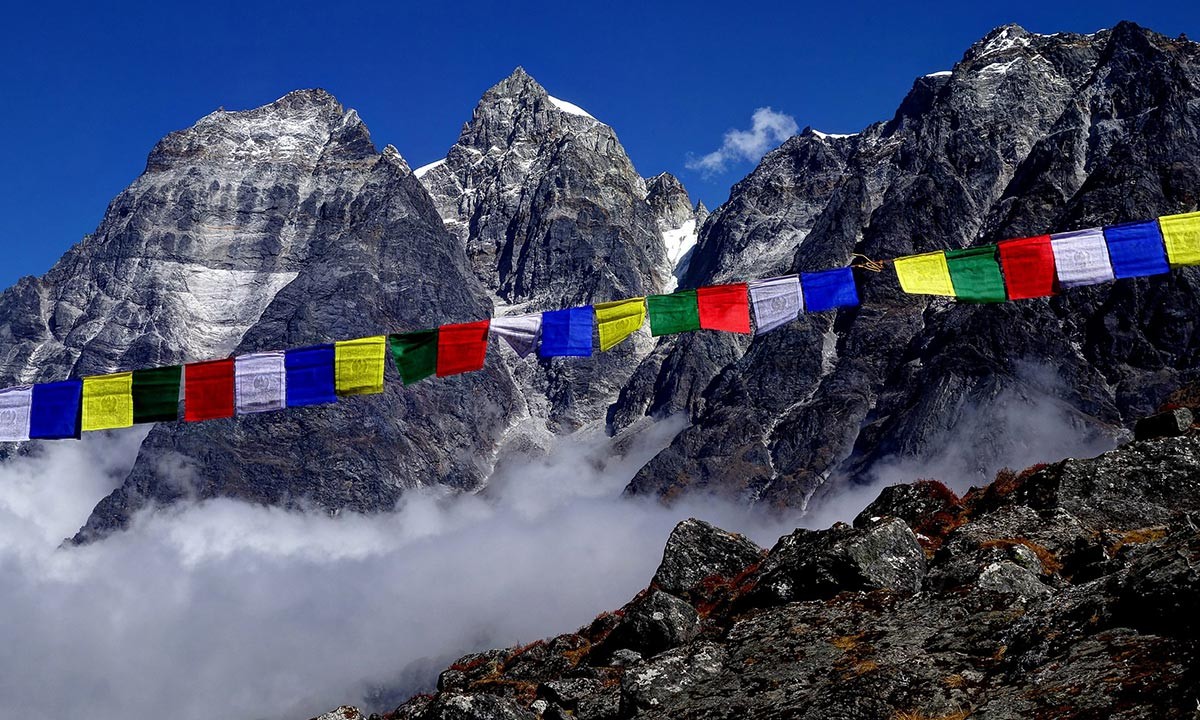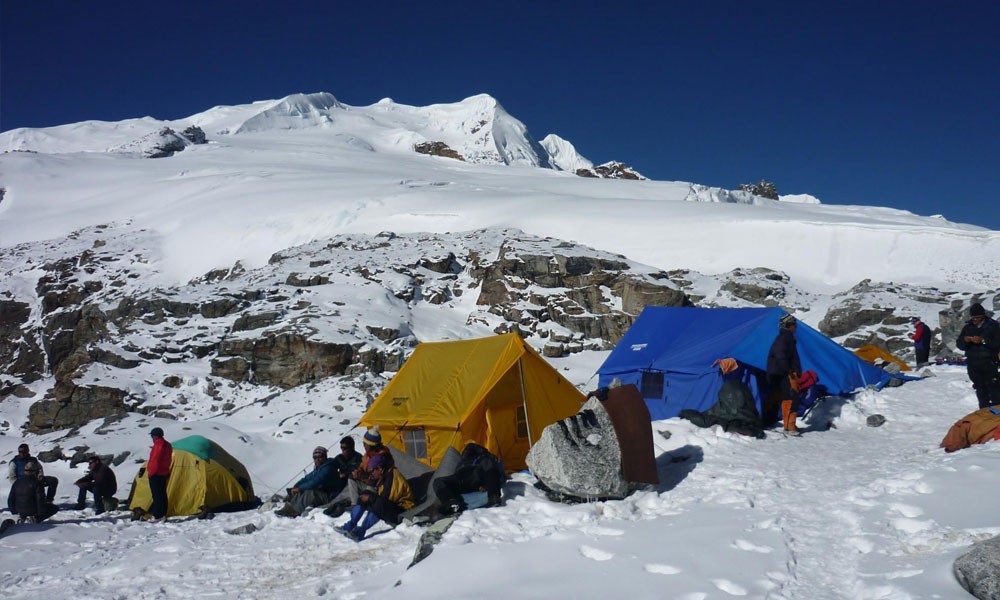 Mera Peak, the highest trekking peak in Nepal, is situated in the Hinku Valley of the Everest Region. Consisting of the three peaks Mera South (6,065 meters), Mera North (6,476 meters), and Mera Central (6,461 meters), this expedition is the conquest of the Mera Central following the less-crowded scenic routes of the Khumbu region. Popular among the mountaineering community as an easy alpine peak and fewer technical segments, Mera Peak Climbing is a famous expedition for the mountaineering enthusiast as a practice peak.
Mera Peak, the highest trekking peak in Nepal, is situated in the Hinku Valley of the Everest Region. Consisting of the three peaks Mera South (6,065 meters), Mera North (6,476 meters), and Mera Central (6,461 meters), this expedition is the conquest of the Mera Central following the less-crowded scenic routes of the Khumbu region. Popular among the mountaineering community as an easy alpine peak and fewer technical segments, Mera Peak Climbing is a famous expedition for the mountaineering enthusiast as a practice peak.
Mera Peak Climbing is one of the few Himalayan expeditions that can be completed within three weeks; following the remote virgin territory of the Hinku Valley, this expedition explores the northward prospects of the Khumbu region. An ideal Himalayan exploration for both beginners; who dream of conquering the 8,000-meter class massifs in the Himalayas and seasonal mountaineers who want to extend their Himalayan portfolio. This immersive, exhilarating adventure redefines the journey of solitude on an off-beaten path exploring the Himalayan wilderness. And leads to the summit that rewards the expeditioners with spectacular views of the five of the highest mountains in the world; Everest, Makalu, Kanchenjunga, Lhotse, and Cho Oyu.
First conquered by the British expeditioner Col. Jimmy Roberts and Sir Tenzing for the first time on 20 May 1953, this Himalayan gem has been a favorite mountain for adventures over the years. Especially as a lucky charm and the first mountain to ascend for mountaineering enthusiasts who are on their first adventure in the Himalayas, aiming to pave the way for greater conquests in the future.
How Technical is Mera Peak?
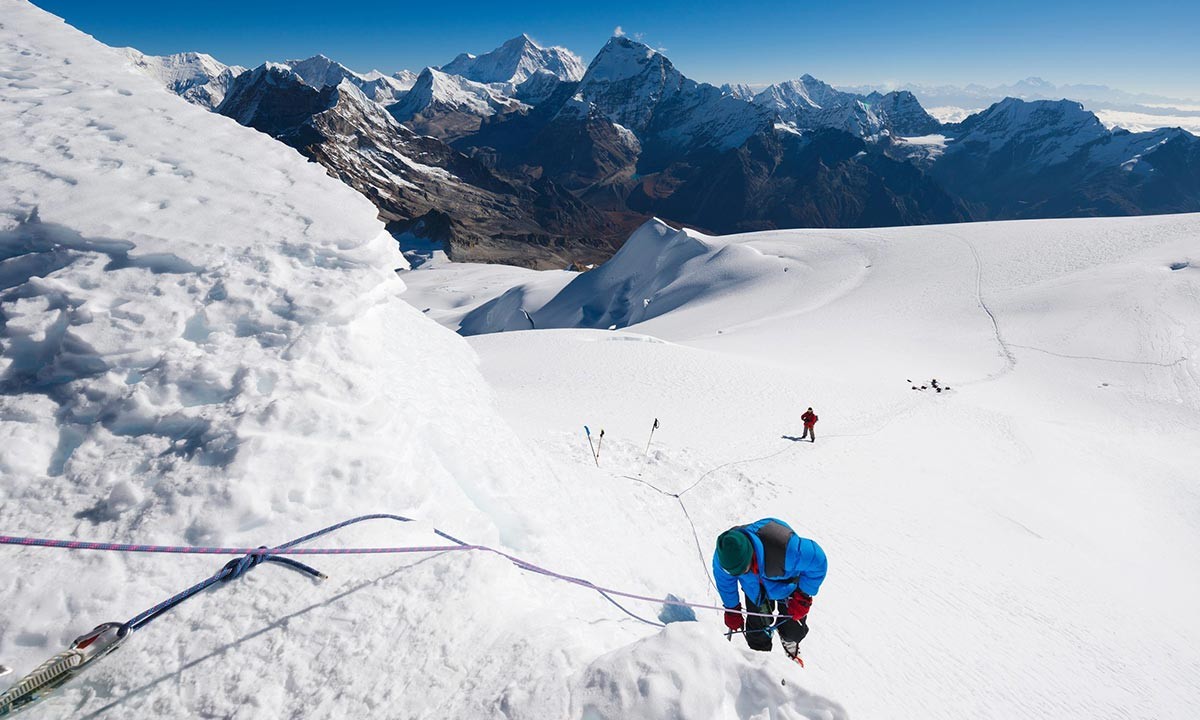 Mera Peak Climbing is a non-technical mountain; it has a pretty much straightforward route to the summit and requires very little technical climbing skills on its normal route. Unlike other alpine mountains that consist of steep technical segments on their slope, Mera Peak Climbing is a pretty much straightforward expedition that just needs mountaineers to use jumars and fixed rope during the last snowy dome segment, 40-50 meters distant from the summit.
Mera Peak Climbing is a non-technical mountain; it has a pretty much straightforward route to the summit and requires very little technical climbing skills on its normal route. Unlike other alpine mountains that consist of steep technical segments on their slope, Mera Peak Climbing is a pretty much straightforward expedition that just needs mountaineers to use jumars and fixed rope during the last snowy dome segment, 40-50 meters distant from the summit.
Although it is not a technically difficult mountain that requires an expert level of mountaineering skills, the significant altitude can be challenging for many. Mera Peak climbing has been graded ‘Alpine Grade PD’ in the Alpine grading system, which means that there are some technical and challenging climbing segments on the slopes of the mountain. The adventure on this magnificent peak of the Himalayas used to have an ‘Alpine Grade F’ rating, which means it was an easy, straightforward ascend to the summit of the mountain.
But, due to the change in the glacier level and the involvement of the technical segment during the final push to the summit, it has now been evaluated as the ‘Alpine Grade PD’ mountain. Thus although the Mera Peak Climbing is considered a non-technical expedition, you will still need to cover a little technical stretch during the final push to the summit. But don’t worry; our expert team will guide you properly throughout the expedition, and you will also receive pre-climb training at Khare for a safe and enjoyable mountaineering experience and how to overcome the technical segment.
Mera Peak Climbing in Spring
The spring season in Nepal (March, April, and May) offers the most exhilarating and gratifying experience of the Himalayan exploration. The weather is mostly stable and warm during this season, with clear spectacular visibility. The green vegetation, lush forest, and wildflowers make it the best time to experience the full bloom of the Himalayan wilderness.
If you are a nature lover, you cannot simply miss the exploration of the region when it is at its peak. In spring, the temperature of the region hovers around 15°C to 20°C during the day time and can as drop as low as 12°C to -8°C during early mornings and night.
Perks of Mera Peak Climbing in Spring
- Colorful flowers and lush greenery at their finest
- Cozy temperature with clear visibility
- Low probability of snowfall and rainfall
- Blooming wildlife and migrating birds
- Longer days are perfect for an immersive adventure
- Tasty seasonal delicacies
Mera Peak Climbing in Autumn
Autumn (September, October, and November) is another peak season for high-altitude adventure in the Himlayas in Nepal. The freshly washed-up terrains and souring rivers nourished by monsoon rains, stable weather, warm temperature, and chilly fresh mornings-nights make it the best season for the Himalayan adventure.
The dry-breezy days, accompanied by the clear blue skies and unprecedented visibility, make it an ideal time to truly immerse in the magnificence of the Himalayan vistas. The day temperature during this peak season fluctuates around 14°C to 20°C and can drop upto 10°C to -5°C during the night.
Perks of Mera Peak Climbing in Autumn
- Pleasant, chilly, and breezy temperatures
- Dry stable weather conditions
- Clear and wide visibility of Himalayan vistas
- More cultural exploration opportunity
- Low probability of rainfall and snowfall
- Opportunity to witness wildlife preparing for hibernation
- Nothing beats photography this season
- No bugs, no leeches
Training and Preparation
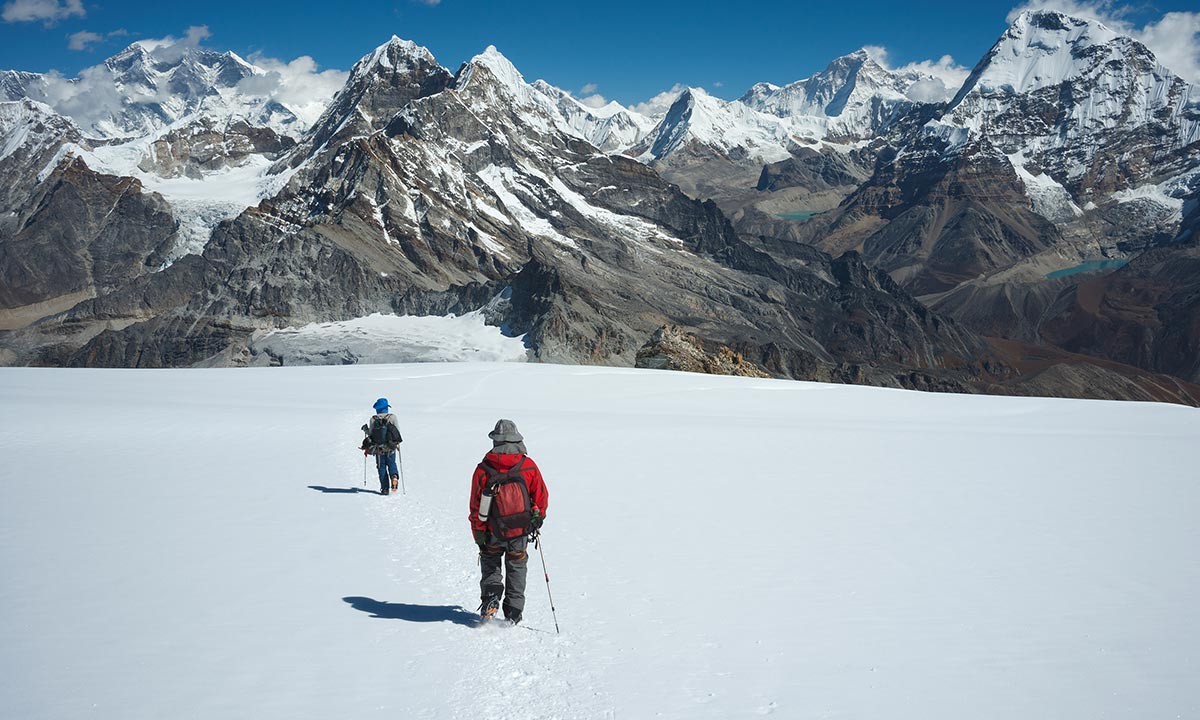 Mera Peak Climbing is a high-altitude adventure in the alpine environment over an altitude of 6,000 meters; thus, preparing for this glorious expedition of the Himlayas, like any other trekking expedition, might not just make the cut. Although Mera Peak is considered the highest trekking peak in Nepal, traversing across the alpine and glacial segment with a slight technical segment near the summit differentiates it from other trekking adventures.
Mera Peak Climbing is a high-altitude adventure in the alpine environment over an altitude of 6,000 meters; thus, preparing for this glorious expedition of the Himlayas, like any other trekking expedition, might not just make the cut. Although Mera Peak is considered the highest trekking peak in Nepal, traversing across the alpine and glacial segment with a slight technical segment near the summit differentiates it from other trekking adventures.
Thus preparing for Mera Peak Climbing 8- 12 weeks prior to the adventure, like other treks, will not be enough. You will actually ascend the mountain slopes with ice and snow segments, so it is recommended that you should start your preparation at least 4- 6 months or longer, if possible, before the expedition. Here are a few exercises you can include in your training regime while preparing for the Mera Peak Climbing.
Strength and Endurance Exercises: Squats, plank push-ups, bicep curls, overhead pass, bench press, dumbbell row, pull-ups, deadlift, weightlifting, bench press, leg curl
Cardiovascular Exercises: Cycling, jogging, swimming, water aerobics, jumping rope, rowing, burpees, dance, pilates, lunges
Mental Preparation: Meditation, practiced breathing to stay calm, boosting confidence, visualization, mental toughness
Food and Accommodation
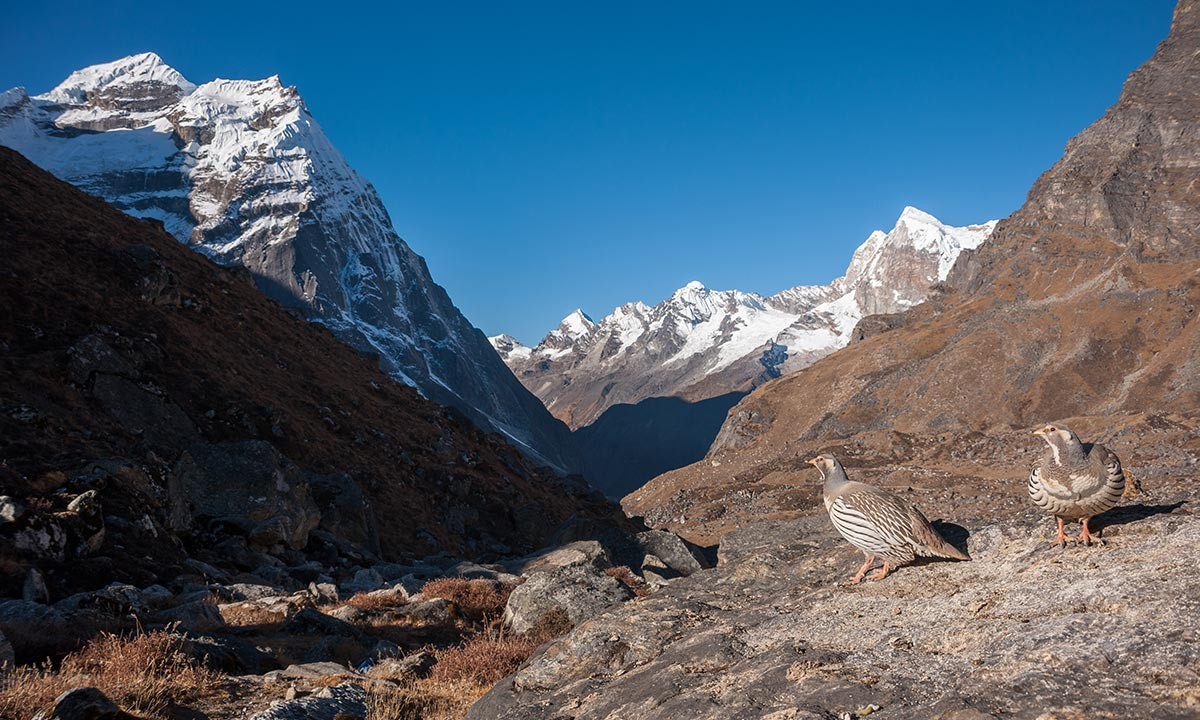 As Mera Peak Climbing explores remote parts of the Himalayas on an off-beaten path from Hongu and Hinku Valley’s prospects, the food and accommodation facilities here might not be top-tier like you expect on the mainstream trekking routes. But, it doesn’t mean that you cannot enjoy exquisite lavish dishes when you join the main trekking route, so you will have to make do with what is available during the exploration of the remote parts of the expedition. Similarly, the lodges are basic in the remote region, with beds, mattresses, pillows, and blankets. Generally, the rooms in the teahouses are on a shared basis, usually two or three beds per room, and the same for the bathroom facilities (shared).
As Mera Peak Climbing explores remote parts of the Himalayas on an off-beaten path from Hongu and Hinku Valley’s prospects, the food and accommodation facilities here might not be top-tier like you expect on the mainstream trekking routes. But, it doesn’t mean that you cannot enjoy exquisite lavish dishes when you join the main trekking route, so you will have to make do with what is available during the exploration of the remote parts of the expedition. Similarly, the lodges are basic in the remote region, with beds, mattresses, pillows, and blankets. Generally, the rooms in the teahouses are on a shared basis, usually two or three beds per room, and the same for the bathroom facilities (shared).
During most parts of your expedition, teahouses along the trail will prepare food for you and arrange accommodation. However, during the ascending period on the mountain, our expert team will arrange the tented accommodation for you at Mera High Camp and prepare warm-nourishing meals. Here are some food menus you can expect in your Mera Peak Climbing.
For Breakfast
- Egg options
- Toast and bread (jam or honey)
- Coffee, tea (milk, black, ginger pepper)
- Pancakes
- Oats
- Soup
- Cornflakes
- Sandwiches
- Chapatti
- Porridge
For Lunch and Dinner
- Thukpa
- Momos
- Sherpa stew
- Macaroni
- Spaghetti
- Potato items
- Yak steak
- Riki kur
- Shyphale
- Rildok
- Daal bhaat tarkari
- Burger
- Spring roll
- Pizza
- Noodles, chowmein
For vegan and vegetarian expeditioners, the teahouses along the trail also have vegan and vegetarian options. You could just request the chef to prepare you a vegetarian or vegan meal, excluding the meat or any other ingredient you dont want.
**Note: During your trekking part, Marvel Adventure will arrange the finest teahouse in the region for the best value food and accommodation facilities**
You may also like:



